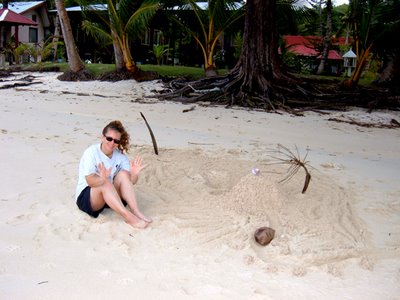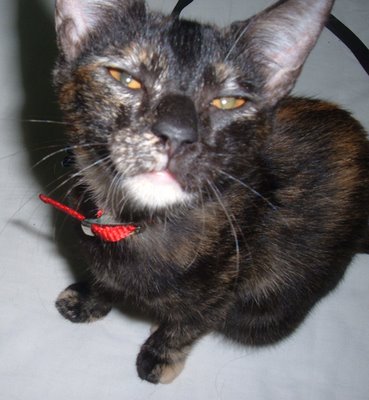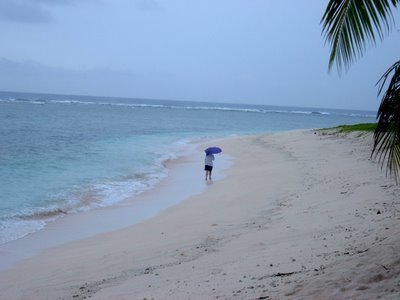Welcome to Greg and Shelly's Micronesia Nostalgia Tour 2006, where vacation took us to our old stomping grounds, Palau and Guam. Shelly served in the Peace Corps in Palau from 1996-1998; I worked on Guam from 1997-2000. It was the first time either of us had been back since leaving. It was good to be back.
* * *
Our trip got off to a rocky start at the airport in Manila, where security officials have taken the prohibition of liquids to the extreme, at least on international flights to the USA. My 1.5 ounce bottle of eye drops was taken at the first security checkpoint. The yogurt which was missed at the first checkpoint was taken at the second checkpoint. We removed our shoes twice. Our bags were searched by hand twice and x-rayed once. At least we were helping George W. Bush win the war on terror. It's so much easier to focus on the potential instruments of terror rather than on the people who to cause terror. Memo to the White House: I'm not planning on bringing down any planes, and neither is Shelly. Tell our allies to lay off a bit, okay?
Once onboard, I settled down and began to enjoy myself, much to my wife's relief. Continental Micronesia has some of the friendliest flight attendants in the world, and it was wonderful to be back in their hands. Plus, redeeming our OnePass miles for travel in Micronesia is without question one of the best value frequent flyer awards around, as long distances and small passenger loads make air travel in Micronesia ridiculously expensive.

Things got better inflight, as the flight deck announced that since we were a bit ahead of schedule, they would be treating us to an aerial tour of Palau. Palau is one of the most beautiful countries in the world, and flying over the thousands of islands reminded me of just how beautiful it is.

Palau has changed so much since the last time I visited, starting with an airport that now boasts its own jetway. The last time I flew into Palau, we disembarked via the air stairs and walked across the tarmac. This is not a bad way to enter a country, unless it's raining. I was also interested in seeing the winglets on Continental's 737-800, which reduce drag and make the plane very fuel efficient. I had read about and new they were quite tall, but this was the first time I had actually seen them in person. And this brings to a close the boring airplane-geek portion of this blog entry.

Our itinerary for Palau included a stop at all of Shelly's old haunts. After checking in to our hotel ("We don't have any electricity at night," the clerk told us, "but we can give you a fan hooked up to a generator." This earned us a free room upgrade so they didn't have to run power cords into the less-expensive rooms.), we hit the street and found a book sale benefiting the Palau Association of Libraries. Since several of Shelly's Peace Corps friends were involved in improving the country's libraries, we stopped by and bought a couple of used paperbacks.

Further down the road, we discovered that Koror now has a Mexican restaurant. A decade ago, the ten-year-old in Shelly's host family referred to tacos and burritos as "Taco Bell food," because he had only seen it on TV commercials -- and when Shelly made tacos in the kitchen.
It turned out that the hotel we were staying at was owned by the guy who publishes one of the country's three newspapers, Tia Belau. Shelly dug right in.


Our first full day in Palau took us to Carp Island, a rustic resort island that caters to divers and, therefore, leaving the island mostly to us non-divers during the day. Carp Island also gave Shelly the opportunity to pick up some smoked fish from Yano's store in Koror, which the island dogs enjoyed as much as we did.
What goes well with smoked fish? Chunks of taro and raw okra fit the bill.



Not too far from Palau -- at least not in Pacific Ocean terms -- is Yap, one of four states in the Federated States of Micronesia. Yap is known for its stone money, huge, round carved stones, invariably with a hole through the center. Much of Yap's stone money, which still has value in the Yapese economy today, was quarried from Palau and carried on outrigger-style canoes hundreds of miles to Yap. Carp Island has two pieces of stone money that never made it Yap, including this one.
Being a small island, Carp has its own power supply. The sign nailed to the building makes it seem a bit grander than it really is. (It's hard to read, but it identifies this building as the Carp Island Power Plant.)

Our last order of business while waiting for the boat to Koror was the construction of this luxurious ocean-front sandcastle. Shelly was in charge of the design, engineering and construction, while Greg handled the excavation and landscaping duties. We were hoping to make a killing on its sale, but then the tide came in and changed our plans.

Our trip back to Koror was sunnier than our trip to Carp had been, so the boat driver took us on a brief tour, including a trip through the rock islands -- lumps of eroding, forest-covered coral limestone -- and the beaches where Survivor Palau was taped.


After the extended beach time at Carp, we spent a day roaming around Koror, eating SureSave fried chicken...

...and going to Palau's new national aquarium, which has done a great job of putting fish in what seem to be very natural environments. One of the displays features Palau's stingless, freshwater jellyfish, which evolved from stinging, saltwater jellyfish after being trapped in a lake in the rock islands. I believe it's still possible to swim with them, though neither of us have done so.

One of the more astonishing sites in Palau is the new national capitol building, which was due to open just after our visit. Built in what can only be described as an American style, the building is gorgeous, but feels out of place in Melekeok, on the rural island of Babeldaob.


Next up, Guam!
 There isn't much to report from our housewarming party -- a lot of Chinese came and had interesting American food and drink -- but there are a couple of photos worth sharing.
There isn't much to report from our housewarming party -- a lot of Chinese came and had interesting American food and drink -- but there are a couple of photos worth sharing.





























































